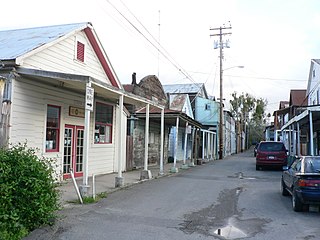
Sacramento is the capital city of the U.S. state of California and the seat of Sacramento County. Located at the confluence of the Sacramento River and the American River in Northern California's Sacramento Valley, Sacramento's estimated 2018 population of 501,334 makes it the sixth-largest city in California and the ninth largest capital in the United States. Sacramento is the seat of the California Assembly, the Governor of California, and Supreme Court of California, making it the state's political center and a hub for lobbying and think tanks. Sacramento is also the cultural and economic core of the Sacramento metropolitan area, which had 2010 population of 2,414,783, making it the fifth largest in California.
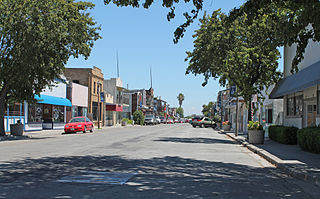
Isleton is a city in Sacramento County, California, United States. The population was 804 at the 2010 census, down from 828 at the 2000 census. It is located on Andrus Island amid the slough wetlands of the Sacramento-San Joaquin River Delta, on the eastern edge of the Rio Vista Gas Field. The city has many preserved 19th-century era storefronts along its main street, some of which show distinct Chinese influences.

The Chinatown–International District of Seattle, Washington is the center of Seattle's Asian American community. Within the Chinatown International District are the three neighborhoods known as Seattle's Chinatown, Japantown and Little Saigon, named for the concentration of businesses owned by people of Chinese, Japanese and Vietnamese descent, respectively. The geographic area also once included Seattle's Manilatown. The name Chinatown/International District was established by City Ordinance 119297 in 1999 as a result of the three neighborhoods' work and consensus on the Seattle Chinatown International District Urban Village Strategic Plan submitted to the City Council in December 1998. Like many other areas of Seattle, the neighborhood is multiethnic, but the majority of its residents are of Chinese ethnicity. It is one of eight historic neighborhoods recognized by the City of Seattle. CID has a mix of residences and businesses and is a tourist attraction for its ethnic Asian businesses and landmarks.
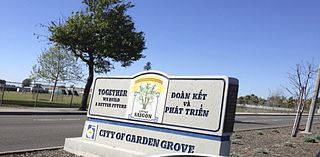
Little Saigon is a name given to ethnic enclaves of expatriate Vietnamese mainly in English-speaking countries. Alternate names include Little Vietnam and Little Hanoi, depending on the enclave's political history. Saigon is the former name of the capital of the former South Vietnam, where a large number of first-generation Vietnamese immigrants arriving to the United States originate, whereas Hanoi is the current capital of Vietnam.

Tape v. Hurley, 66 Cal. 473 (1885) was a landmark court case in the California Supreme Court in which the Court found the exclusion of a Chinese American student from public school based on her ancestry unlawful. State legislation passed at the urging of San Francisco Superintendent of Schools Andrew J. Moulder after the school board lost its case enabled the establishment of a separate but equal segregated school, like the contemporaneous Plessy v. Ferguson (1896).
This article discusses Chinatowns in the Americas. The regions include: Canada, the United States, and Latin America.
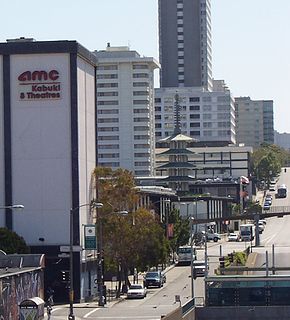
Japantown is a neighborhood in the Western Addition district of San Francisco, California.

Japantown is a historic residential, commercial, and cultural district of San Jose, California, north of Downtown San Jose.

Japantown is a common name for official Japanese communities in cities and towns outside Japan. Alternatively, a Japantown may be called J-town, Little Tokyo or Nihonmachi (日本町), the first two being common names for the Japanese communities in San Francisco, San Jose and Los Angeles, respectively.
The Asiatic Exclusion League, often abbreviated AEL, was an organization formed in the early twentieth century in the United States and Canada that aimed to prevent immigration of people of Asian origin.

The Chinatown neighborhood in Oakland, California(Chinese: 屋崙華埠), is a pan-Asian neighborhood which reflects Oakland's diverse Asian American community. It is frequently referred to as "Oakland Chinatown" in order to distinguish it from nearby San Francisco's Chinatown. It lies at an elevation of 39 feet.

Old Town Chinatown is the official Chinatown of the Northwest section of Portland, Oregon. The Willamette River forms its eastern boundary, separating it from the Lloyd District and the Kerns and Buckman neighborhoods. It includes the Portland Skidmore/Old Town Historic District and the Portland New Chinatown/Japantown Historic District, which are listed on the National Register of Historic Places.
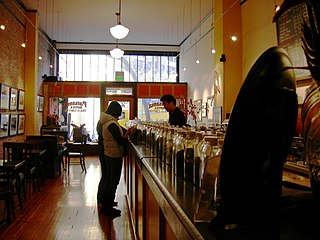
The Panama Hotel in Seattle, Washington's International District was built in 1910. The hotel was built by the first Japanese-American architect in Seattle, Sabro Ozasa, and contains the last remaining Japanese bathhouse (sento) in the United States. The Panama Hotel was essential to the Japanese community, the building housed businesses, a bathhouse, sleeping quarters for residents and visitors, and restaurants. Since 1985 the Panama Hotel has been owned by Jan Johnson. Johnson, the third owner of the Panama Hotel has restored the building to emulate its previous condition before the evacuation of the Japanese in Seattle. Johnson has closed off the basement that holds the belongings of the Japanese families to the public, and has installed a glass panel in the floorboards for visitors to view the artifacts from above.
Mary Tsuruko Dakusaku Tsukamoto (1915–1998) was a Japanese American educator, cultural historian, and civil rights activist. She had taught in the Elk Grove Unified School District in Sacramento, California, for 26 years, and was described as having a passion to teach children how to learn from experience. The daughter of Japanese parents, she was relocated to an internment camp at Jerome, Arkansas, after the United States entered World War II. She developed a program about the internment period that is part of the California state curriculum for fifth grade history and a California Museum of History tour exhibit. She worked for Japanese American civil liberties, and played a pivotal role in the grassroots effort that led to the Civil Liberties Act of 1988. She also worked with the Smithsonian Institution in Washington DC, where she developed an exhibit on internment for the Constitution's bicentennial. In March 2006, she was posthumously recognized as a National Women's History Month honoree.
This article contains a list of the Chinatowns, which are either officially designated neighborhoods or historically important, in the United States. Historically speaking, many of these Chinatowns were formed in the 1800s Chinese diaspora and have served as ethnic Chinese enclaves.

The Isleton Chinese and Japanese Commercial Districts is located in Isleton, California in the Sacramento–San Joaquin River Delta, a large agricultural area in Sacramento County, California. Also known as the Isleton Asian American District, it served as the commercial and social center for both the town's Chinese and Japanese residents and the laborers working in nearby canneries, farms, and ranches. Isleton Asian American District is the only Asian community built in the Delta during the 1920s, and the architectural style of the buildings in the districts, particularly the use of pressed tin siding, is unique to other Delta Asian communities and to the town of Isleton.
There is a Japanese American and a Japanese national population in San Francisco and the San Francisco Bay Area.

Oriental Public School, founded as The Chinese School, was a public school located in Chinatown, San Francisco, California. It was initially set up in 1859 as a segregated school for schoolchildren of Chinese descent, part of the growing anti-Chinese sentiment in the United States that arose in the late 1800s. The school has been renamed a number of times, most recently in 1998 to the Gordon J. Lau Elementary School in honor of the city's first Chinese-American supervisor.




